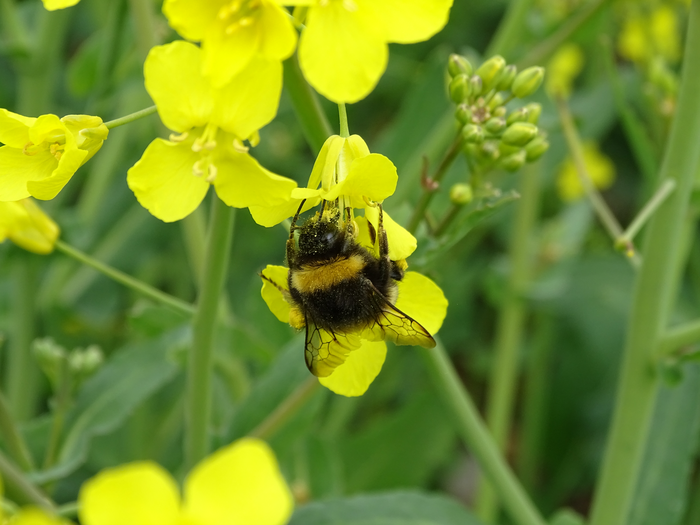With the arrival of spring, bumblebee queens take their first wing beat of the season and set out to find new nesting sites. But they are flying earlier in the year, as a result of a warmer climate and a changing agricultural landscape, according to new research from Lund University in Sweden.
“We risk losing additional bumblebee species, and having less pollination of crops and wild plants”, says researcher Maria Blasi Romero at Lund University.
When spring arrives and the ground warms up, bumblebee queens wake up from hibernation. Contrary to workers and males, queens are the only bumblebees that survive the winter, and they spend a couple of weeks finding a place to nest, where they can lay eggs and start a colony.
However, rising temperatures mean that they wake up earlier in the year. The new study shows that in Sweden, the first flight occurs on average five days earlier than twenty years ago.
“Across Sweden, we see that the increased temperatures due to climate change clearly affect when the queens wake up and fly to find a new nest”, says researcher Maria Blasi Romero.

Credit: Maria Blasi Romero/Lund University
With the arrival of spring, bumblebee queens take their first wing beat of the season and set out to find new nesting sites. But they are flying earlier in the year, as a result of a warmer climate and a changing agricultural landscape, according to new research from Lund University in Sweden.
“We risk losing additional bumblebee species, and having less pollination of crops and wild plants”, says researcher Maria Blasi Romero at Lund University.
When spring arrives and the ground warms up, bumblebee queens wake up from hibernation. Contrary to workers and males, queens are the only bumblebees that survive the winter, and they spend a couple of weeks finding a place to nest, where they can lay eggs and start a colony.
However, rising temperatures mean that they wake up earlier in the year. The new study shows that in Sweden, the first flight occurs on average five days earlier than twenty years ago.
“Across Sweden, we see that the increased temperatures due to climate change clearly affect when the queens wake up and fly to find a new nest”, says researcher Maria Blasi Romero.
It is not only the temperature that has an impact. The researchers have used the Lund Biological Museum’s collection to examine bumblebee queens as far back as 117 years ago, in different areas of southern Sweden. This data shows that the first bumblebee flight in intensively farmed landscapes now takes place about fourteen days earlier than over a century ago.
Reduced biodiversity with modern agriculture
The major change in the examined landscapes during the past century is the loss of grassland habitats, such as meadows and permanently grazed pastures. Today, large agricultural fields dominate and often only a few different crops are grown. This has led to a general decline of farmland biodiversity.
Bumblebee queens leaving their hibernation much earlier nowadays is therefore likely due to a warmer climate, a lack of food during the flight period, and more varying microclimatic conditions in today’s agricultural landscape compared with the more diverse landscapes of older times.
The researchers have focused on ten bumblebee species and found that the species that already used to fly earliest in the season have become even earlier flyers, while the species that emerge later in the season have not changed their flight season. There is a risk that this leads to a poor match between the activity periods of flowering plants and bumblebees, and that bumblebees do not get enough food.
“We see a clear risk that more bumblebee species are at risk of extinction locally, especially the species that usually emerge later in the summer. This could also lead to a decline in the number of bumblebees overall and that would have consequences for the pollination of crops and the functioning of ecosystems. Bumblebees are important pollinators, especially in northern latitudes such as in Scandinavia”, says researcher Anna S Persson.
“Climate change and changing land use are two of the biggest threats to biological diversity. Different species respond differently to these changes, so it is important to know more about how and why that is. There are winners and there are losers among species”, says researcher Romain Carrié.
Actions that slow down the effects
The study highlights several measures that could reduce the effects of climate warming on pollinators and increase their access to flowering plants. A few examples are:
– Preservation of natural grasslands, such as natural pastures.
– Late season mowing at roadsides, after the flowering period.
– Flower strips and hedges designed in a way that favors pollinators.
– Increased sowing of clover-rich leys, that are partly allowed to flower.
Journal
Biodiversity and Conservation
DOI
10.1007/s10531-023-02563-5
Article Title
Historical and citizen-reported data show shifts in bumblebee phenology over the last century in Sweden




